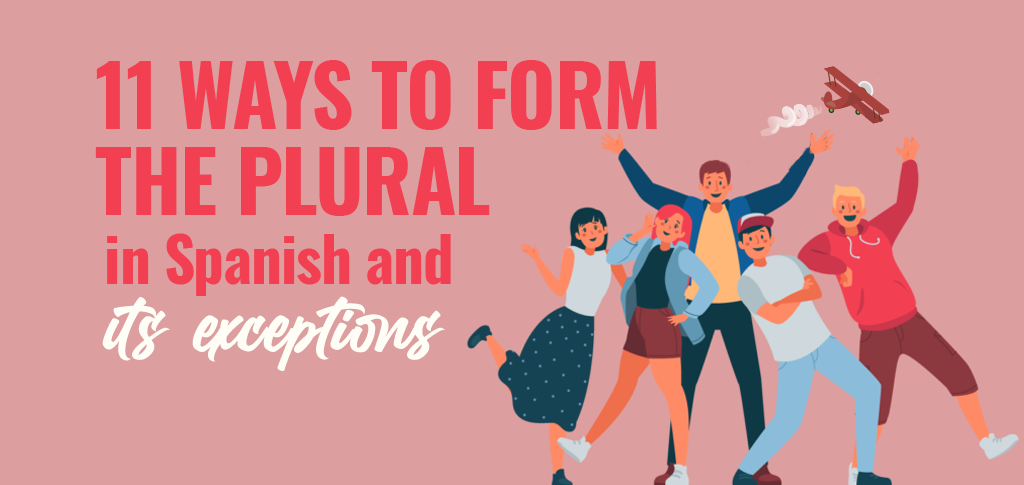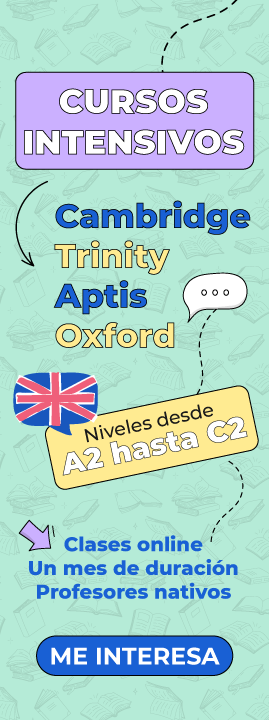11 ways to form the plural in Spanish and its exceptions

To form the plural, and as a general rule, we add -so -es according to the spelling rules of the Spanish Royal Academy.
ÍNDICE DE CONTENIDOS
But there are words that come out of that rule, there are exceptions that I am going to mention in these lines.
The easiest rules
- Nouns ending in an unstressed vowel (-a, -e, -i, -o, -u) , form the plural by adding an -s
Libro – libros, book – books
mesa – mesas, table – tables
casas, estudiantes, taxis, planos, tribus. – houses, students, taxis, planes, tribes.
- Nouns and adjectives ending in -á or -ó tonic , form the plural with -s
Papá – papás, daddy – daddies
sofá – sofás, sofa – sofas,
buró – burós, bureau – bureau,
rococó – rococós, rococo – rococo,
dominó – dominós. dominoes – dominoes.
- If the last letter is a stressed -í or -ú , both plurals are allowed: adding -s and adding -es
Wild boar – wild boars / boars, Jabalí – jabalís / jabalíes,
bamboo – bamboos / bamboos, bambú – bambús / bambúes
- Nouns ending in consonants -d, -j, -l, -n, -r form the plural by adding -es
Computer – computers, ordenador – ordenadores
Watch watches. reloj – relojes
- If the word ends in -z , it becomes a c before adding -es
Cross – crosses, Cruz – cruces,
pencil pencils lápiz – lapices
fish fishes, pez / peces,
light / lights, luz / luces,
voice / voices. voz / voces.
- Foreign words that end in a consonant form the plural by adding -s or
-it is
Club – clubs – Club – clubs / clubes-
- When the plural is formed by adding -es , the word gains one syllable. As the stressed syllable is maintained, it may be necessary to add or remove the accent depending on whether the resulting word is flat or esdrújula
Exam – exams, examen – examenes
institution – institutions, institución – instituciones,
specimen – specimens, espécimen – especímenes,
character – characters. carácter – caracteres.
- The nouns ending -so -x and unstressed syllable one remain unchanged plural
Cactus – cactus. Cactus – cactus.
- Nouns ending in -ú and -í, form the plural by adding -so -es
Scalpel – scalpels / scalpels, Bisturí – bisturís / bisturíes,
taboo – taboos / taboos, tabú – tabús / tabúes,
ruby – rubies / rubies. rubí – rubíes / rubís.
- If they end in -s or -x and are acute words, then form the plural by adding -es
Bus – buses. Autobús – autobuses.
- Nouns ending in -é make the plural with -s
Coffee – cafes, Café – cafés.
promissory note – promissory notes, pagaré – pagarés.
skirting board – skirting board. rodapié – rodapiés.
Specific grammar structures
- Nouns that can be used both singular and plural to refer to a single element
Scissor scissors, Tijera – tijeras.
pants – pants. pantalón – pantalones.
- Words that do not admit plural , are always used in the singular
Money, Dinero
hunger, hambre
adolescence, adolescencia
panic, pánico
avarice, avaricia
Health, salud
complexion, tez
the cardinal points, north, south, east and west. los puntos cardinales, norte, sur, este y oeste.
- Words that are always used in the plural (they do not admit singular)
Glasses, gafas
nuptials, nupcias
tongs, tenazas
holidays, vacaciones
- The esdrújulas or serious words ending in -s -x do not change in the plural. The accompanying article will indicate the number (singular or plural).
Can opener, Abrelatas
virus, virus
centipede, ciempiés
railing, pasamanos
pencil sharpener, sacapuntas
the days of the week Monday, Tuesday, Wednesday, Thursday, Friday, Saturday and Sunday. Los días de la semana lunes, martes, miércoles, jueves, viernes, sábado y domingo.
- There are compound words that only modify the second element
Railway – railways, Ferrocarril – ferrocarriles.
Spanish-speaking – Spanish-speakers, hispanohablante – hispanohablantes
deaf-mute – deaf-mute, sordomudo – sordomudos
Hail Mary – Hail Mary, avemaría – avemarías.
welcome – welcome. bienvenido – bienvenidos.
- The word that ends in -s or -xy are not acute , it remains unchanged to form the plural, that is, it stays the same, only the article will indicate the number
The parentheses, El / los paréntesis
the virus / el / los virus
the birthday (s), el / los cumpleaños
the biceps. el / los bíceps.
- The nouns and adjectives in -y preceded by a vowel form the plural -es,
Law – laws, Ley – leyes
ox – oxen, buey – bueyes
convoy – convoys, convoy – convoyes
Special cases
Words in the singular that change their meaning in the plural
Zeal : can indicate the transparent adhesive tape; or the period of reproduction of the animals.
Jealousy : feeling of mistrust towards the person you love when you fear that you love another.
There are many more, I invite you to review the article on this topic. very interesting!
The last names
To form the plural of surnames , the same rules that apply to common names apply, if such surnames are used in a generic sense.
The century of the Cervantes,
of the Quevedos,
of the Gracianes.
El siglo de los Cervantes,
de los Quevedos,
de los Gracianes.
The surnames ending in -az, -anz, -ez, -enz, -iz, -inz , which are always invariable, are excepted .
The Velázquez,
the Istúriz,
the Diaz,
the Herranz.
Los Velázquez,
los Istúriz,
los Díaz,
los Herranz.
Doubtful plurals
Any – any,
sunshade – sunshade,
turning – turning,
whoever – whoever,
deaf-mute – deaf-mute,
bocamanga – bocamangas.
Cualquier – cualesquiera,
quitasol – quitasoles,
bocacalle – bocacalles,
quienquiera – quienesquiera,
sordomudo – sordomudos,
bocamanga – bocamangas.
Nouns from other languages must be adapted to Spanish by substituting y for i and adding -s
Pantyhose (from English panty) – pantyhose,
ferri (from English ferry) – ferries.
Panti (del ingl. panty) – pantis,
ferri (del ingl. ferry) – ferris.
The nouns ending in -ch , coming from other languages, to form the plural, some add -es or others simply remain unchanged
Sandwich – sandwiches,
the chromlech / s,
the Tsarévich (s).
Sándwich – sándwiches,
el / los crómlech,
el / los zarévich.
Yes and no
They form the plural with -es .
As a pronoun and as an adverb it remains unchanged; that is, it cannot be pluralized for any reason; On the other hand, as a noun, they do have a plural.
No, it’s not,
Yes it is.
No – noes,
Si – sies.
Just as the plural of no and yes is formed by adding -es to pluralize the word I, -es or only -s is also added.
I – I’s / I’s
Yo – yoes / yos
The numbers
When numbers function as nouns, they form their corresponding plural just like the rest of the words in Spanish. If they end in a vowel, an -s is added , and if they end in a consonant, -es is added.
Five – fives,
six – sixes,
Take into account that the plural of:
Two – twos,
twelve – twelve,
ten – ten.
Cinco – cincos,
seis – seises,
Tomar en cuenta que el plural de:
Dos – doses,
doce – doces,
diez – dieces.
Expressive plural
A characteristic of Spanish is that, generally, the greeting is given through its traditional plural form or expressive plural, which does not denote quantity but intensity .
Good morning Good Day),
good afternoon (good afternoon),
good night (good night),
Greetings (greeting).
Buenos días (buen día),
buenas tardes (buena tarde),
buenas noches (buena noche),
Saludos (saludo).
The musical notes
Although they are often used as invariables, their plural is formed by adding -s , except in the case of sol, which forms the plural with -es
My – my,
re – res,
sun – suns,
si – sis.
Mi – mis,
re – res,
sol – soles,
si – sis.
Plural of Abbreviations
If the abbreviation was obtained by truncation, add -s
P. page by page. págs. por páginas.
The plural of abbreviations cent is excepted. (Cent, hundredth) and cent. (Cent), which is cts.
In abbreviations made up of a single letter, the plural is expressed by doubling the letter.
- USA – United States, UU. – Estados Unidos,
- H.H. – Social media SS. – Redes Sociales
If the abbreviation was obtained by contraction, the general rules of plural formation apply and -so -es is added depending on the ending
- Dept. / Dept. – departments,
- admones. – administrations.
Dptos. / Deptos. – departamentos,
admones. – administraciones.
As an exception :
- You (you) – You (you). Ud. (usted) – Uds. (ustedes).
If the abbreviation corresponds to a verb form, the same form is used for the plural as for the singular.
Cp. – compare / compare,
DEP – Rest in peace / Rest in peace.
Cp. – compárese / compárense,
D. E. P. – Descanse en paz / Descansen en paz.
Colors
For the plural, color names follow the following guidelines:
When they function as nouns, they make the plural according to the general rules,
The whites,
The roses,
The crimsons or crimsons,
The Blues.
Los blancos,
Los rosas,
Los carmesíes o carmesís,
Los azules.
If, to designate shades, the name of color goes together with a noun, the latter remains unchanged .
The bottle greens,
The pearl grays.
When they work as adjectives.
Red skirts,
Green pants,
Blue eyes.
Los verdes botella,
Los grises perla.
Cuando funcionan como adjetivos.
Faldas rojas,
Pantalones verdes,
Ojos azules.
More important details
- In sentences made up of two nouns , and the second acts as a modifier, only the first is plural.
Rush hours,
Skorts,
Bedroom cities,
Child prodigies,
Sofa beds.
Horas punta,
Faldas pantalón,
Ciudades dormitorio,
Niños prodigio,
Sofás cama.
- But if the second noun can work, as an attribute of the first in copulative sentences , it will also be plural.
Member states,
satellite countries,
leading companies,
keywords.
Estados miembros,
países satélites,
empresas líderes,
palabras claves.
Proper names
Since proper nouns, unlike common ones, do not designate classes of beings, but rather serve to identify a single being among those of their class, they are not usually used in the plural. However, since there are beings that share the same proper name, it can be used in the plural to designate several referents.
The Javieres,
the Pablos.
Los Javieres,
Los Pablos.
The surnames remain unchanged when they designate the members of the same family.
The Garcia,
the Martinez.
Los García,
los Martínez.
The surnames that end in -z are always kept unchanged.
The Hernandezes,
the Diaz.
Los Hernández,
los Díaz.
The names of notorious dynasties or families also waver. Most tend to remain unchanged:
The Habsburgs,
the Tudors, the Borgias;
Los Habsburgo,
los Tudor, los Borgia;
But others are almost always used with plural markings
The Bourbons,
the Habsburgs,
the Capulets.
Los Borbones,
los Austrias,
los Capuletos.
- When a trademark or company names are used to designate several objects manufactured by said brand, if the name ends in a vowel, it is usually used with the ending -s characteristic of the plural , while, if the name is compound or ends in a consonant, it tends to remain unchanged.
Yamahas motorcycles,
Opel cars,
various Zaras stores,
two Benetton stores,
the new Corte Ingles.
Las motos Yamahas,
los coches Opel,
varias tiendas Zaras,
dos locales Benetton,
los nuevos Corte Inglés.
- Shortenings, when they are nouns, usually follow the general rules of plural formation , but some of them, such as super and hyper, remain unchanged.
Photo (photography) – photos,
cinema (cinematograph) – cinemas,
bus (bus) – buses.
Foto (fotografía) – fotos,
cine (cinematógrafo) – cines,
bus (autobús) – buses.
I hope it is very useful for you. Leave any questions or comments below.



